- Retour accueil
- Vous êtes ici : Blog The Pyramids of the Cold The Pyramids of the Cold Section 18 • the Sarcophagus
The Pyramids of the Cold Section 18 • the Sarcophagus
Publié par Bruno Coursol dans The Pyramids of the Cold le 12/04/2022 à 19:59
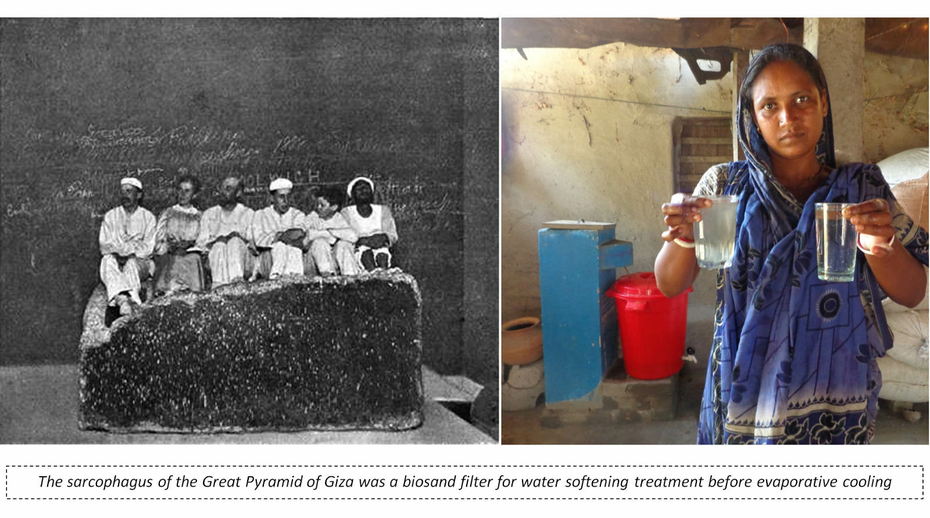
The coffer of the Great Pyramid of Khufu : "Great Pyramid Passages" Volume 1, Plate CXXV page 250, by John and Morton Edgar in 1910 : https://archive.org/details/GreatPyramidPassagesVol11910Edition/page/n259/mode/1up
Production of drinking water by biosand filtration : https://wiki.lowtechlab.org/wiki/Water_-_Biosand_Filter#
The Pyramids of the Cold - Section 18 • the Sarcophagus
In summary : the sarcophagus of the Great Pyramid of Giza, was a biosand filter for water softening, originally operated in the little room located between the antechamber and the entry to the Grand Gallery.
The water treatment by biosand filtration is producing drinking water, but it was performed to control scale, corrosion, and microbiological growth within the evaporative cooling process in the horizontal passage of the pyramid.
Despite the sarcophagus filtration and the softening of the water used to power up the Great Pyramid, salt encrustations in both the horizontal passage and the Queen's chamber were discovered by the first explorers of the pyramid. The salt deposits were up to one-half inch thick, before being removed in 1998 under the supervision of Zahi Hawass, as Director General of the Giza monuments.
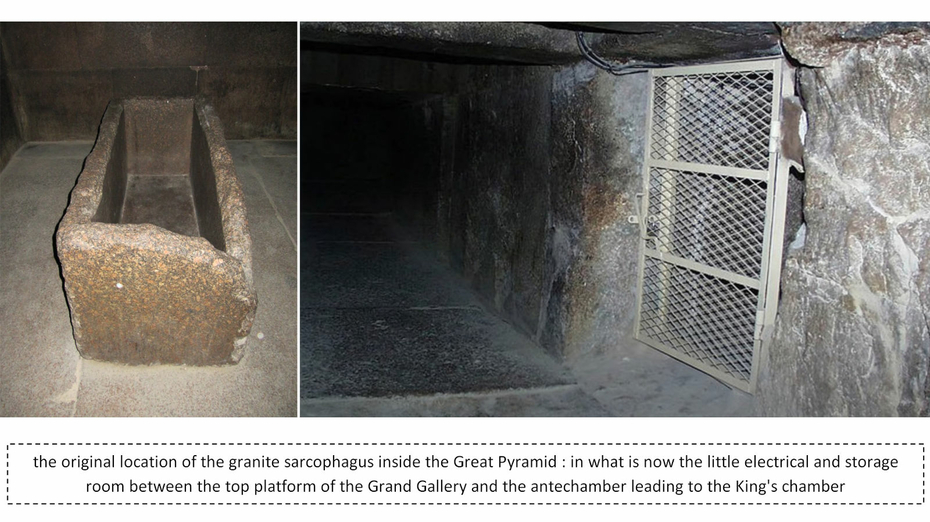
18.01 The original location of the sarcophagus
The granite "sarcophagus" found in the King's chamber of the Great Pyramid of Giza, for many reasons couldn't have been designed for the mummy of pharaoh Khufu : there is absolutely no sign, decoration or hieroglyph nowhere on the object, nor there is anywhere in the King's chamber or in the entire pyramid, if we don't consider the quarry marks found in the "relieving " chambers.
Plus, the granite box has been meticulously hammered down, on its entire top surface as well as along the slot on one of its corners. That work alone, would have take maybe 30 minutes or a full hour to realize for one person ; and for what other reason than to hide the specific design that was implemented onto these parts, and maybe because the box was simply not operated in the King's chamber, where it had been found and it had to be taken out from where it had been neatly installed originally, and taken out of there with force.
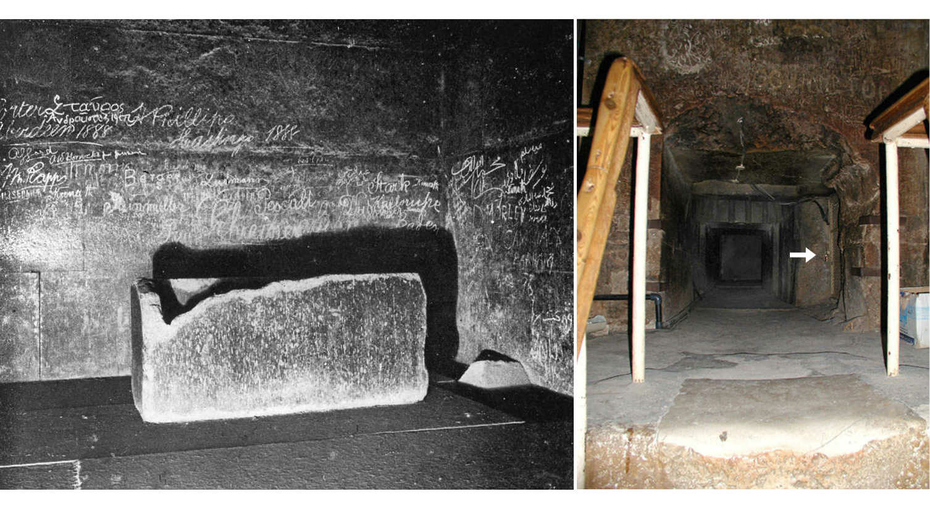
The sarcophagus of the Great Pyramid of Giza and the location where it had been operated for water treatment as a biosand filter, in between the antechamber and the opening to the Grand Gallery. The photograph on the right has been taken from the top of the Grand Gallery.
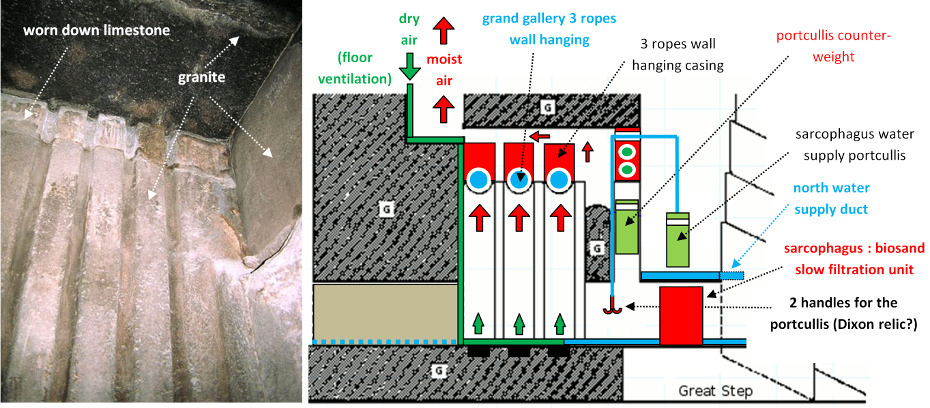
Photograph on the left : the 4 grooves on the south granite wall of the King's antechamber of the Great Pyramid of Khufu at Giza. Please notice that the entire chamber is built with massive granite blocks, but surprisingly the top of this south wall is made of very worn out and very low-quality limestone. In my opinion, this limestone had been added after the pyramid shut-down, when this chamber didn't need to be connected to the exterior anymore for ventilation.
18.02 The Antechamber drying room
The sarcophagus was set in a complex structure that was supplying it with water from the main water tank of the Great Pyramid : the King's chamber. The amount of water that was feeding the sarcophagus was most probably controlled by a portcullis system similar to the one that was set in the Bent Pyramid of Khufu's father, Sneferu (see above images).
It is possible that the control of the portcullis was done from the antechamber slab stone, but from here everything looks very blur to me.
What really was the antechamber, a drying room for the 3 ropes of the Hauling Beetle is discussed in Section 12.
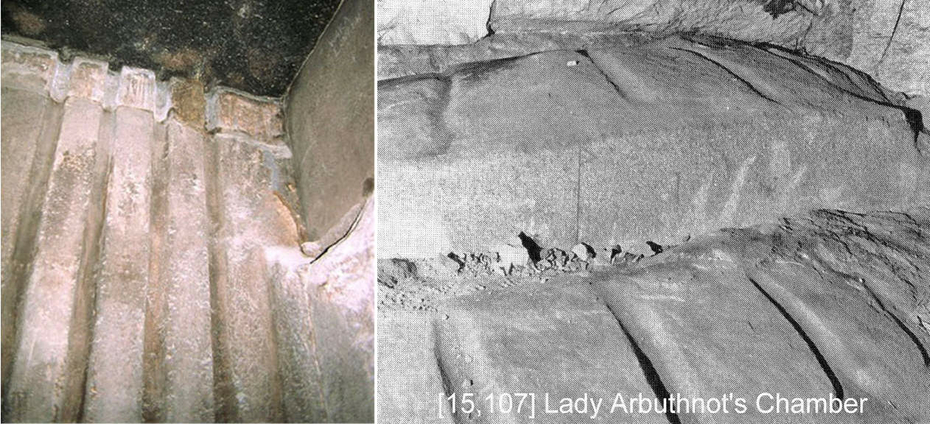
The 4 air duct imprints in the Lady Arbuthnot's chamber are the continuation of the 4 grooves of the antechamber's south wall.
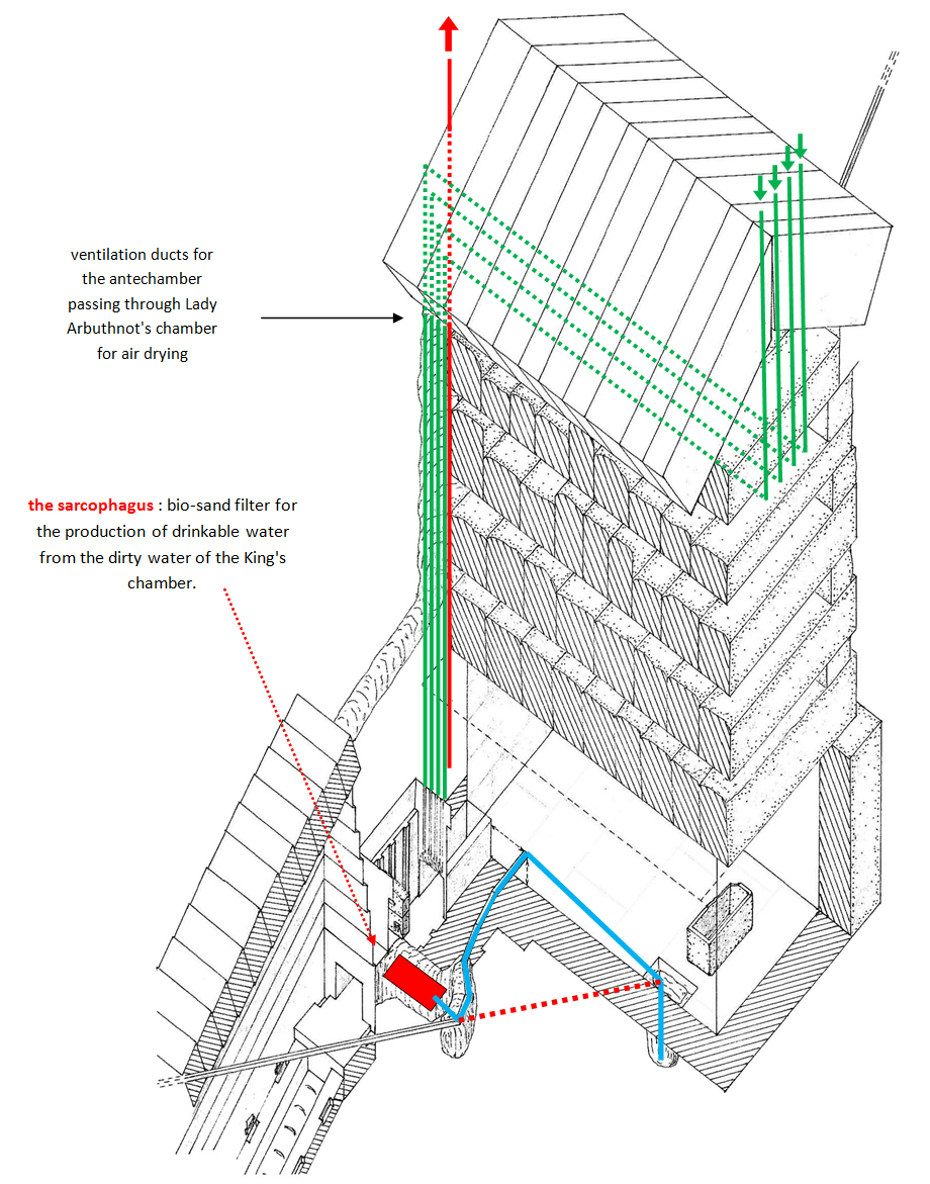
Original drawing by Franck Monnier : https://en.wikipedia.org/wiki/Great_Pyramid_of_Giza#/media/File:Kheops-chambre-roi.jpg
18.03 The traces of the original location of the sarcophagus
On the above drawing from Franck Monnier, we can very easily see where the sarcophagus was set during the operation period of the Great Pyramid of Giza.
Please note the intensive digging that had been made around the sarcophagus water supply shaft, either because something technologically important needed to be wrecked by ancient Egyptian themselves (most probably the portcullis apparatus), or because someone in modern times, guessed that something important was happening here and tried to find out more.
Please also note that the 4 air ducts would have passed right through what is described today as part of a forced tunnel, presumably digged by Vyse.

The strange trajectory of the northern King's chamber shaft of the Great Pyramid of Giza.
Original images thanks to the Bibliothèque nationale de France. "Histoire de l'art égyptien d'après les monuments, depuis les temps les plus reculés jusqu'à la domination romaine" 1858-1879, by Émile Prisse d'Avennes (1807-1879). © Bibliothèque nationale de France, département Réserve des livres rares : http://passerelles.bnf.fr/grand/pas_2457.htm
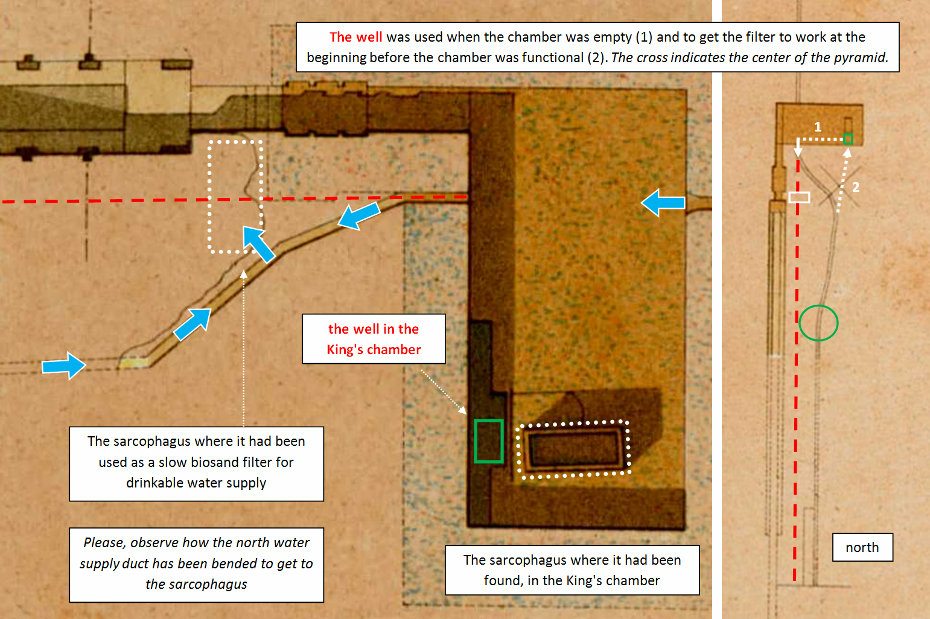
18.04 The strange trajectory of the northern King's chamber shaft
The first thing to note is that if the northern shaft as a very particular trajectory, it is because it was designed to come close to the sarcophagus. In this area, everything was built around the sarcophagus : the red dotted line indicates what would be the exact duplicate of the southern King's chamber shaft, obviously something was supposed to be right on the trajectory.
The second part is a little tricky to understand, because the above drawing is in 2 dimensions only. What one need to mentally add to this draw is the height data : the shaft is going up from the King's chamber to the exterior of the pyramid.

"Modeling Improved Performance of Reduced-Height Biosand Water Filter Designs" by James A. Phillips and Samuel J. Smidt, and published on MDPI : https://www.mdpi.com/2073-4441/12/5/1337
18.05 The extreme diversity of biosand filter designs
The images that are illustrating this part of the study are about biosand filters, designed to provide clear drinkable water in people's homes.
These biosand filters are perfectly adapted to fit in people's homes, but they can be find in many shapes and sizes, in particular there are a lot of high capacity sand filters with the exact same shape as the sarcophagus of the Great Pyramid, as shown below.
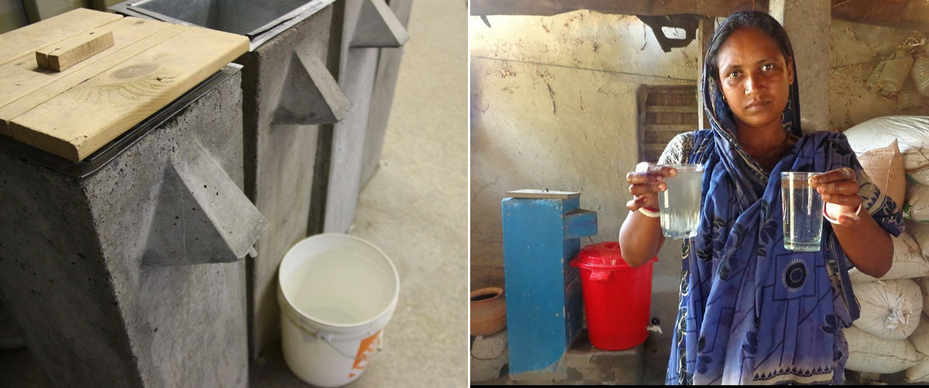
Photographs from : https://wiki.lowtechlab.org/wiki/Water_-_Biosand_Filter#
18.06 The sarcophagus was a biosand filter for water softening for the evaporative cooling process
I first thought that the sarcophagus found in the King's chamber was a biosand filter for production of drinking water for the crewmembers of the Hauling Beetle, but I have to admit it was a little… romantic, I would say.
Nowadays, evaporative cooling is a extraordinary process, but like every process it has some disadvantages, and the most problematic is surely limescale : salt encrustation.
4500 years ago, ancient Egyptians had to deal with that same problem, and they did exactly what we do today : they softened the water coming from the King's chamber, and they used sand filtration.
The most amazing thing is that everybody knows the sand filter that was used inside the Great Pyramid to soften the water : it is the sarcophagus
18.07 The well of the King's chamber and the biofilm of the biosand filtration
It is possible that the well inside the King's chamber, could validate the idea that the sarcophagus was a biosand filter, with a living biofilm on its surface, because it would have been a perfect water reserve to secure the biofilm even when the chamber was empty.
In biosand filters, it is crucial that the biolayer stays under water all the time. If the upper layers of the filter get dry, the biolayer dyes and the filter will need 30 days to get a functional biolayer back, starting when water is coming back into these upper layers.
We know that the water that powered the Great Pyramid, was coming from the annual flood of the Nile, and there was most probably very irregular water levels, regularly or in some particular periods of time.
The well would have saved the biolayer when water supply was failing.
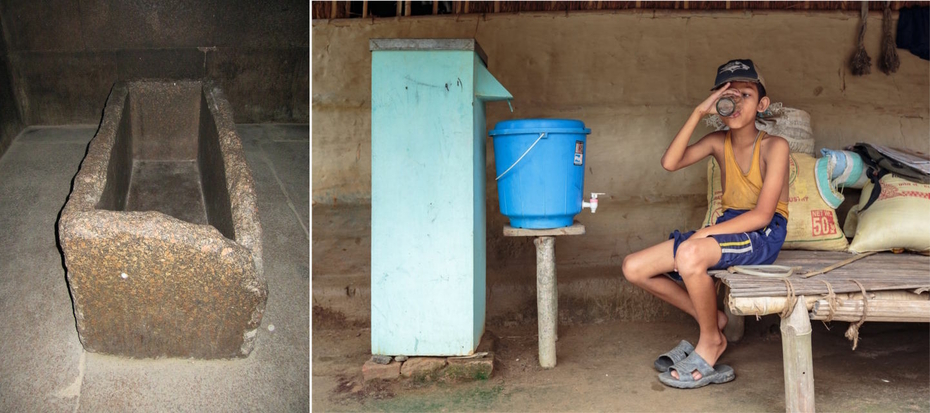
The sarcophagus of the Great Pyramid of Giza, was a biosand filter originally operated in the little room located between the antechamber and the entry to the Grand Gallery. The water treatment by biosand filtration was to control scale, corrosion, and microbiological growth within the evaporative cooling process.
"Ram Pokherai drinks clean water from his family's biosand filter. Clean water helps children stay healthy, which means they are less likely to need time away from school, so their education improves. Providing clean water has important knock-on effects." Courtesy of Editorial, Humanitarian & Travel Photographer Gavin Gough : https://www.gavingough.com/clean-water-in-rural-nepal
Images from this assignment are being used to raise awareness of the important work that Centre for Affordable Water and Sanitation Technology, CAWST is doing, providing the resources and education required for reliable clean water supplies in rural areas. https://www.cawst.org/
18.08 Why is water treatment important in an evaporative cooling system?
I first thought that the sarcophagus found in the King's chamber was a biosand filter for production of drinking water for the crewmembers of the Hauling Beetle, but I have to admit it was a little… romantic, I would say.
Evaporative cooling is a extraordinary process, but like every process it has some disadvantages, and the most problematic is surely it's maintenance. Because water is everywhere in the process, many problems are coming from that water, and the first thing to do is to start with water as clean and as sterile as possible.
Before water starts the evaporative cooling, it needs to be filtered, and that was the function of the sarcophagus, as a biosand filter. More on the sarcophagus in Section 18.
Excerpt from the website of EVAPCO, Westminster, Maryland, United States : https://www.evapco.com/faq/answer/water-treatment-evaporative-cooling-system
"Effective water treatment works to control scale, corrosion, and microbiological growth within an evaporative cooling system. It also helps to ensure heat transfer efficiency and extend the service life of the equipment."
"When an evaporative cooling system rejects heat to the atmosphere, only pure water is evaporated. As this occurs, the dissolved ions—naturally occurring in the makeup water source—are left behind. Without proper water treatment, the dissolved ion concentration increases as evaporation continues and, at some point, will reach saturation of the ions, which can lead to scale. The most common form of scale is calcium carbonate. Preventing scale via water treatment impacts the efficiency of heat transfer, thereby reducing energy consumption of the entire system."
"Microbiological growth in evaporative systems can lead to accelerated corrosion rates, heat transfer deficiencies due to biofilm, as well as human health related concerns. There are a variety of reasons why one system may experience higher biological activity than another. Tower location, nearby construction or farming operations, the makeup water source, and more can all lead to an increased level of bacteria in the water."
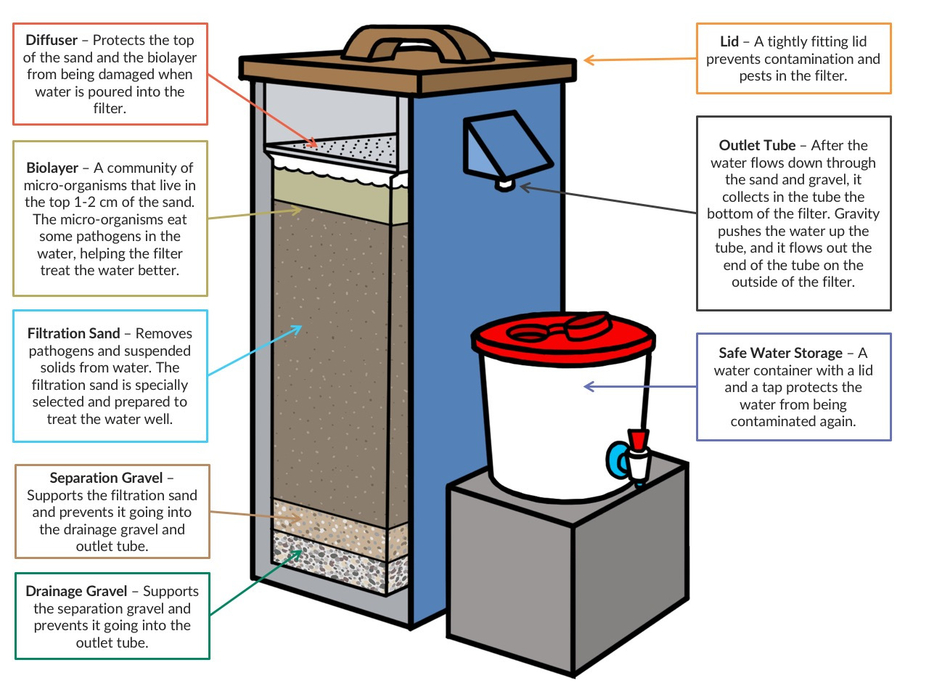
Functioning of a Biosand filter for drinking and softening water production : https://www.cawst.org/services/expertise/biosand-filter/more-information
18.09 What is a Biosand Filter ?
A biosand filter (BSF) is an adaptation of the traditional slow sand filter, which has been used for community drinking water treatment for 200 years. The biosand filter is smaller (about 1 m tall, 0.3 m wide on each side) and adapted so that it does not flow continuously, making it suitable for use in people’s homes. The filter container can be made of concrete or plastic. It is filled with layers of specially selected and prepared sand and gravel. The sand removes pathogens and suspended solids from contaminated drinking water. A biological community of bacteria and other micro-organisms grows in the top 2 cm of sand. This is called the biolayer. The micro-organisms in the biolayer eat many of the pathogens in the water, improving the water treatment.
Pathogens: micro-organisms in water that make us sick
Suspended Solids: dirt and other small pieces in the water (may also be called “turbidity”)
Source : https://www.cawst.org/services/expertise/biosand-filter/more-information
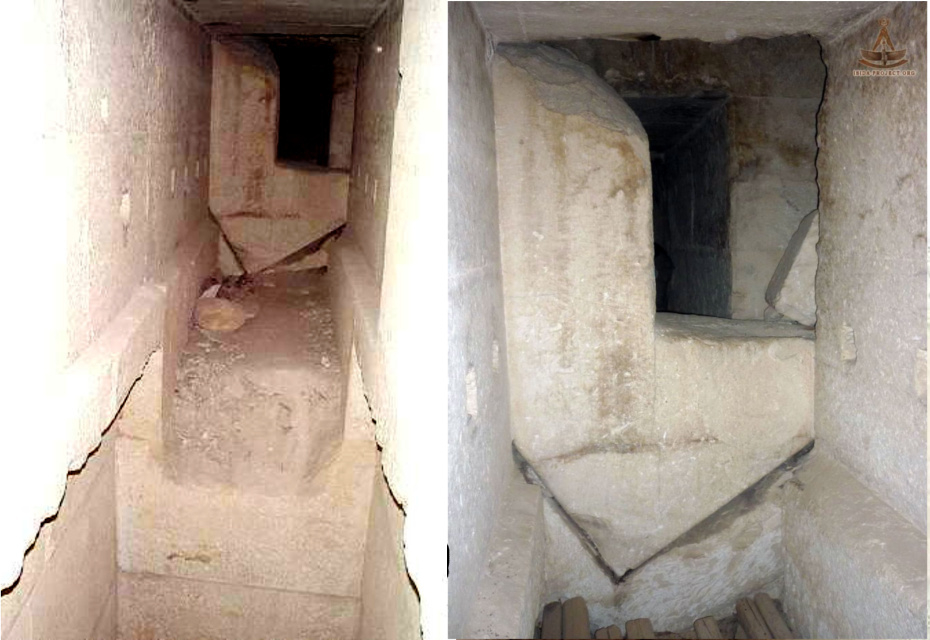
The sand filter of Sneferu's Bent Pyramid, in the east-west passageway that has its entrance on the west face of the pyramid (this is at the first portcullis, at the western side of the passage). Images from guardians.net : https://guardians.net/egypt/cyberjourney/dahshur/bentpyramid/bent_pyramid_interior.htm
18.10 The sand filter of the Bent Pyramid
The reason I'm confident that the sarcophagus was for sand filtration, is that this equipment was already in use in the Bent Pyramid of King Sneferu. Obviously, it is not something that egyptology is talking about, and in the academic studies about this pyramid, it looks like it was preferred to be forgotten.
But it is here : a perfect sand filter, with (most probably) its original sand and the water supply portcullis that is neatly adapted to the filter.The reason I'm confident that the sarcophagus was for sand filtration, is that this equipment was already in use in the Bent Pyramid of King Sneferu. Obviously, it is not something that egyptology is talking about, and in the academic studies about this pyramid, it looks like it was preferred to be forgotten.
But it is here : a perfect sand filter, with (most probably) its original sand and the water supply portcullis that is neatly adapted to the filter.
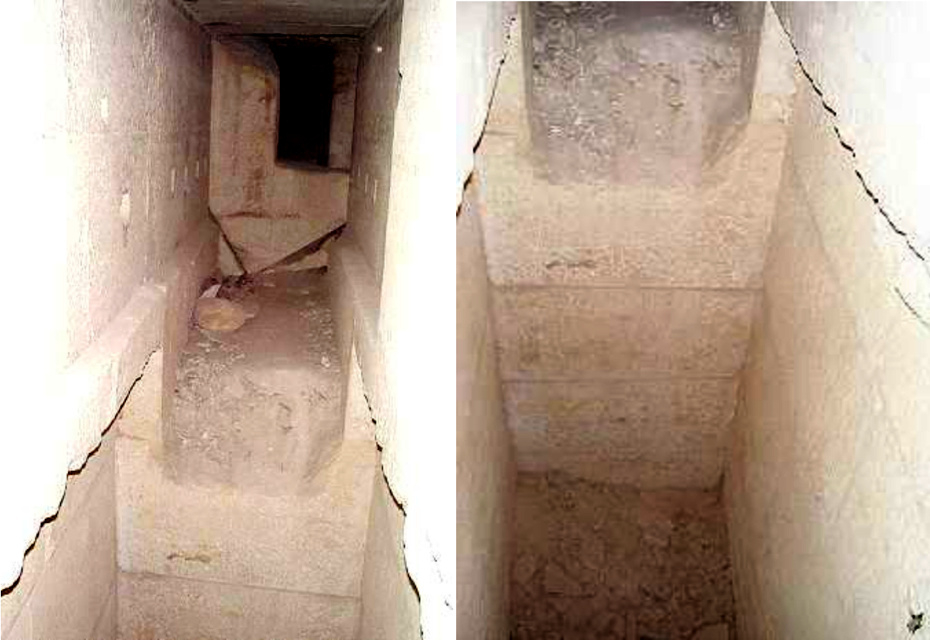
On the above photographs, the curious L shape of the portcullis is only due to formers egyptologists that needed to get pass through the portcullis, so they neatly cut it out.
18.11 Why was the Bent Pyramid sand filter for ?
Why did the Bent Pyramid has been built for, looks much more difficult to comprehend.
I would say it served the purpose of being a last series of trials before the Great Pyramid was built.
For example the lower section could have served for the development of a more efficient limestone kiln with the chimney that would have been air intake, and the sand filter could have been the "prototype" of the sand filter in the Great Pyramid.
I think that the fact this pyramid has two separate entrances on two different faces, and that starting at a 52° angle it suddenly changes to a more gradual angle of 43°, is because they wanted to try many things on this pyramid.
18.12 The umpteenth changed of plans and the foolish idiots
Once again, the idea that Sneferu's engineers changed their minds at the very last minute, because they realized that at 52° angle, the pyramid would have been too high, is outrageous.
Everyone on Earth is fascinated by the extraordinary ancient Egyptian artifacts beauty, that could only come from a very advanced civilization, and in the same time they accept the idea that they were also foolish idiots.
We should be ashamed of ourselves… this is my personal opinion.
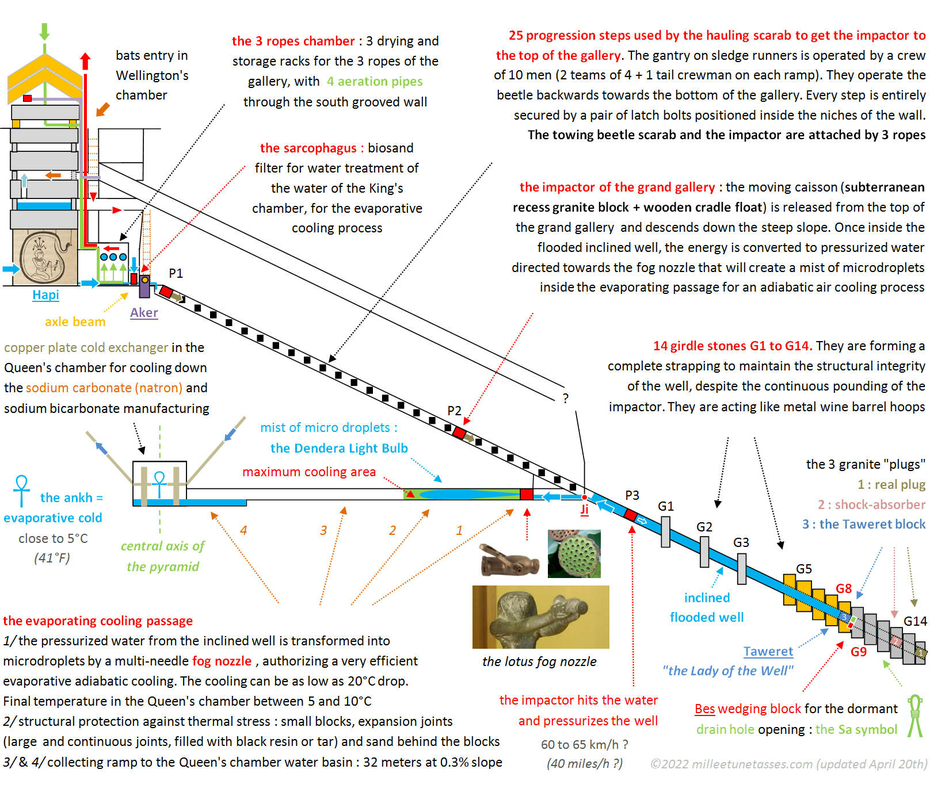
Diagram of the Great Pyramid of Giza in operation, with the biosand filter sarcophagus.
18.13 Summary of the study : hidden behind the academic vision of the ancient Egyptian religion, a vast number of metaphors are describing some of the most advanced science and technological knowledge of that time : ancient Egyptian gods were nothing else than pharaohs' metaphoric self-glorifications of their theoretical and experimental scientific accomplishments in physics and chemistry.
Pharaohs used the power of Science to legitimate themselves as kings of Egypt : they forged an entire religion, based on science to rule their kingdom, and they presented that science as Magic.
The end game of this technological program that probably started on the very first Dynasty, was the Great Pyramid of Giza where evaporative cooling was engineered in the known part of the pyramid from the pressurized water produced in the inclined well, known today as the ascending passage.
The evaporative cold simply took advantage of the power of water, and was most probably necessary to cool down chemical manufacturing of sodium carbonate and sodium bicarbonate produced by an ammonia-soda Solvay process, as suggested by the very strong ammonia smell and the limestone kiln in the so-called burial chamber of the Red Pyramid. At that time, sodium carbonate was called natron, and it was the salt used for the mummification of the pharaohs (Sections 14, 15 and 16).
The cooling seems to have represented the most difficult part of the process, as suggested by the Step Pyramid's official name : according to scholars, the very first pyramid complex, the Step Pyramid of Djoser, was called "the refreshment of the Gods". No doubt that a more accurate translation would certainly be "the cooling of the Gods".
It means that ancient Egyptians were the first civilization to master a Solvay-like process for sodium carbonate manufacturing, long before it got reinvented in the 1800's in Europe. The key elements of that process is the temperature control of the chemical reactions (the cooling), and the dome shaped plate necessary for the counterflow chemical reactions to occur in an efficient way. That counterflow reaction plate is what really is the disc of Sabu.
As shown with Akhenaten and Nefertiti, the creation of the evaporative cold was the most sacred accomplishment of all (Section 17), and this is exactly what the Dendera Light is all about : the Dendera Light is the fog of microdroplets of liquid water that evaporates and creates the cold. Talking about the snake inside the Dendera Light Bulb : "The field surrounding Ra’s snake form is referred to in ancient Egyptian literature as protective magical energy in liquid form that all gods and pharaohs possess" (Faulkner, Section 2).
Everything that had been done in the Great Pyramid of Giza inspired most of the ancient Egyptian religion, and it had been glorified into what we know today as the Underworld.
The Underworld is referring to the chambers and passages of the Great Pyramid of Khufu, and in particular to the Grand Gallery where a hauling gantry beetle operated a wooden coffin shaped impactor that had a small nested granite block inside it. The impactor generated endlessly, over and over, maybe every 15 minutes the pressurized water that was then transformed into a fog of microdroplets inside the horizontal cooling passage.
The Grand Gallery of the Great Pyramid where the act of hauling was done, is the "Secret Hauling Cavern of the Underworld" described in the Amduat "Book of the Hidden Chamber".
The most important chamber of the Great Pyramid wasn't the King's chamber that only was the main water tank of the pyramid, but the Queen's chamber, the only one on the central axis of the pyramid. Because the Queen's chamber was inaccessible from the rest of the pyramid, it was glorified into the "Hidden Chamber of the Underworld" (Section 11), and because the Queen's chamber was the coolest place in the pyramid (about 5°C / 41°F), and with a constant 100% Humidity rate, this chamber was the one where the biggest amount of very hard salt encrustation had been documented by the first explorers of the pyramid in the 1800's and before it had been removed in 1998 by Zahi Hawass (Section 1). Very hard salt encrustation is the signature of the evaporative cooling process, even nowadays.
The most incredible thing is that pretty much everything I've just said, actually appears in one single myth, but it doesn't originate from ancient Egypt : it is the "Churning of the Ocean" Hindu myth that produces the immortal nectar Amrita. The fact is that the endless churning of water that ends up with the production of an elixir that gives eternal life, is exactly what were doing ancient Egyptians in the inclined well : natron was the salt used for the mummification of pharaohs.
Natron gave eternal life to pharaohs, just like the Amrita (Section 19).

The Pyramids of the Cold
Poster un commentaire
